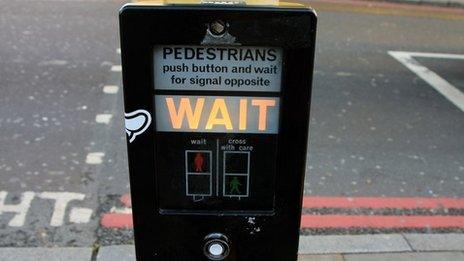'Intelligent' pedestrian crossings trialled in London
- Published
Traffic lights london
Pedestrian crossings that detect how many people are waiting to cross the road are to be trialled in London.
The device uses technology that adjusts traffic signal timings if required, giving people longer to cross.
Transport for London (TfL) said the new mechanisms would make it safer and easier for people to use crossings.
TfL said the first trials - outside Balham and Tooting Bec Tube stations - would make traffic signals "more intelligent".
Mayor of London Boris Johnson said he was delighted that the capital would be the first city in the world to trial the equipment.
The Pedestrian Split Cycle Offset Optimisation Technique (Scoot) will use cameras that can detect how many people are standing on the pavement and then extend the green crossing light to allow more people to cross the road, TfL said.

Pedestrians in parts of London could now have longer to cross
TfL is also developing "call cancel" mechanisms that will stop the green man signal when the person who has pushed the button has already crossed, or walked away.
Leon Daniels, managing director of surface transport at TfL, said: "These new trials of pedestrian detection technology will allow our traffic signals to become even more intelligent, bringing huge benefits to those waiting to cross the road where there is heavy pedestrian demand."
The first phase of pedestrian countdown signals, which tell people how long they have left to cross the road once the green pedestrian light has gone out, has recently been completed.
Countdowns have been installed at about 550 crossings at 200 locations across 30 London boroughs.
Last July, TfL published Safe London Streets, external, a strategy that outlines proposals to reduce the number of people killed and seriously injured on London's streets by 40% by 2020.
- Published26 February 2014
- Published10 May 2013
- Published6 June 2013
- Published30 April 2013
- Published4 December 2012